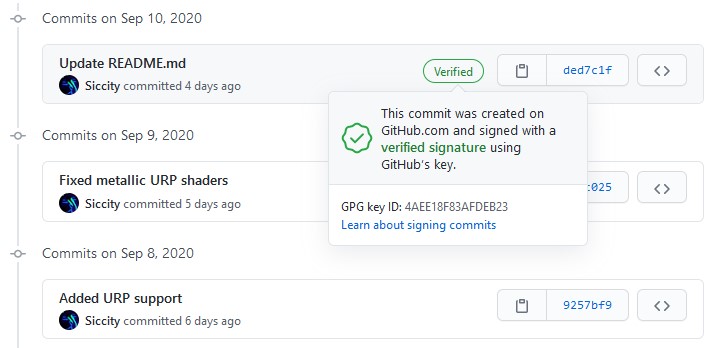Verified GitHub Commits using GPG Keys
If you have ever created a new GitHub repository directly from their web interface, you might have noticed that the first commit you made has a special verified tag attached to it. The same tag doesn't show up for commits made locally. However, it'll be there for any commits made from the web interface.
 Verified Commit Example from GLTFUtility Repo
Verified Commit Example from GLTFUtility RepoYou can enable same commit verification pretty easily by setting up GNU Privacy Guard or GPG keys.
Most of the things you need to know for this are already documented in the official documentation. The process is very similar to setting up SSH authentication.
Exporting the Keys for Using from Another Local System #
Now that you have a key with which you can sign your commits, it'd be great if you can use the same key while signing from a different environment or system.
To do that, you can first export both private and public key pairs as below...
$ gpg --export-secret-keys -a YOUR_KEY_ID > key_private.asc
$ gpg --export -a YOUR_KEY_ID > key_public.ascNow copy these ASCII text files to the system/environment where you want to use them
Remember you are sharing the private key also. So take caution on how you are copying it to the other system/environment.
And then on the other environment, import them as follows...
$ gpg --import key_private.asc
$ gpg --import key_public.ascAfter it is done, you'll also need to trust the keys to use it without any issues.
Type the following command in git bash (or bash if you are in Unix environment)...
$ gpg --edit-key 14CD2ADD54953E3CIn the gpg prompt that you'll get, execute the following command and select a trust level.
gpg> trust
...
1 = I don't know or won't say
2 = I do NOT trust
3 = I trust marginally
4 = I trust fully
5 = I trust ultimately
m = back to the main menuConfigure Git to Use the Key #
And then follow the same procedure to add the key to your local Git configuration and commit with -S flag. Git will automatically sign your commits with the same key.
To make it more seamless, you can change the custom add-commit command I had mentioned in an earlier post to include the -S flag as well.
Another way to sign all commits,is to configure your Git environment as follows
git config --global commit.gpgsign trueAlso, if you are working from a command line only interface, add the following to your .bashrc so that the signature verification prompt appears. Otherwise you might end up with some GPG error without any helpful message.
export GPG_TTY=$(tty)